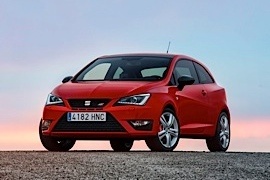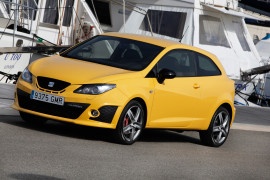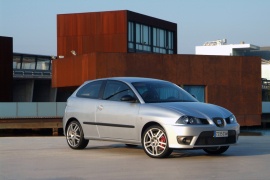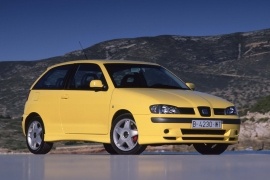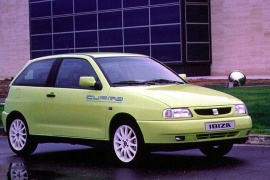SEAT Ibiza Cupra Models/Series Timeline, Specifications & Photos
First production year: 1996
Engines: Gasoline, Diesel
Body style: Hatchback
The 2013 Ibiza Cupra was the top-version of the small-class vehicle from Seat. It was a small hot-hatch that could challenge the reigning hot-hatch champion, the Clio Renault Sport.
When the compact hot-hatches became more and more powerful and more expensive, there was a niche market for more affordable cars that could offer enough performances. The top contender was, for many years in a row, the Renault Clio Renault Sport. Its handling and the rev-happy engine was one of the best on the market. Then, the Volkswagen Group has decided to offer the Polo GTI and its more affordable version, the Ibiza Cupra.
The Seat Ibiza was unveiled at the 2008 Geneva Motor Show and the model range featured a 5-door hatchback, a 3-door version and a 5-door estate, the latter was added in Q4 2010. The Ibiza Cupra was offered as a three-door coupe with different bumpers and a more aggressive styling. The bi-xenon headlights were a standard feature of the car, and the LED daytime running lights as well. Specific 17” light-alloy wheels were fitted as standard.
Inside, there was a new steering wheel that featured the Cupra logo on its bottom. Behind it, there were the shifting paddles for the DSG gearbox. The sport-bucket seats were upholstered in two-tone leather as an option. For the infotainment unit, Seat featured the Seat Portable System that included GPS and Bluetooth connectivity.
For the drivetrain, the Ibiza Cupra featured a 1.4-liter TSI engine, carried-over from the Polo GTI. It was mated to a standard 7-speed double-clutch gearbox (DSG). Power went to the front wheels via an XDS electronic transverse differential lock that reduced the understeer tendency and improved handling, particularly during fast cornering.
Seat unveiled the fourth generation of the small size vehicle Ibiza at the 2008 Geneva Motor Show. One year later, it added the sportiest version for that range, the Cupra.
After the hot-hatch car segment grew both in size and price, there was a gap to be filled, with sporty models and more affordable prices. The Ibiza Cupra was one of the versions that came to fill that gap, along with the Clio RS, Polo GTI, or Corsa OPC.
The top performer Cupra was visually enhanced on the exterior when compared with the rest of the Ibiza range. For the beginning, there were 17” light-alloy wheels fitted as standard and a special, dark design for the front mesh-grille. In the rear, the word Cupra stands on the liftgate in chromed letters.
Inside, there are sport-bucket seats for the front passengers with a special upholstery that combined man-made leather and fabric. In the rear, there was less room for adult passengers. Since the Cupra had a three-door configuration only, the access was more difficult. The trunk had enough room for daily purchases. The standard feature list was bigger than on the rest of the range, including a CD/MP3/Radio, automatic climate control, and paddle-shifters behind the flat-bottom steering wheel. The Cupra logo was mounted on the bottom of the steering wheel.
The Cupra came as standard with the 1.4-liter compressor-turbocharger engine that offered 180 hp mated to a standard 7-speed DSG (dual-clutch) automatic gearbox. The power went to the front wheel and an electronic system helped to reduce the wheelspin.
As part of the Volkswagen Group, SEAT made the Ibiza on the same platform as the Polo and received most of its engines, including the 1.8-liter turbocharged.
The Europeans started to ask for hot-hatches, and besides the usual carmakers such as Volkswagen, Renault, Opel, Fiat, and Honda, SEAT joined the club and offered sportier versions. The Spaniards named those versions as Cupra (copper), and the Ibiza was the smallest to receive such a treatment.
With its rounded shapes and big headlights, the Ibiza was already a known vehicle on the market. The Cupra version was a surprise that came with a different front bumper that featured a broad grille on the lower side and two fog-lights on its outer part. Its wheel-fenders were slightly enlarged to emphasize the sporty look of the car. To complete the image, SEAT installed bigger wheels and a roof spoiler.
Since it was available only in a three-door version, the Ibiza Cupra offered great access for the front occupants and was limited to the rear bench. The front sport bucket-seats featured a special logo embroiled on the front seats seatbacks and contrast stitching upholstery. For the instrument cluster, the carmaker installed white dials.
Under the hood, SEAT installed the 1.8-liter, 20-valves turbocharged Volkswagen engine. It was the same four-pot used in the Audi A3, Audi TT, Volkswagen Polo GTI, and Golf GTI. It was paired as standard to a five-speed manual gearbox. A diesel version was offered as well.
When SEAT introduced the second facelift for the Ibiza's second generation, Volkswagen granted it with one of its best four-pot engines on the market: the 1.8-liter turbocharged unit.
Sometimes, the 1999 Cupra was also known as the Ibiza MK3, and it is easy to understand why. Its look was way different than the 1993 Ibiza. Also, it gained many technological improvements when compared to that one. The second facelift allowed the Spanish carmaker to keep the car on the market until 2002, which was longer than the regular lifespan of a vehicle built in the '90s.
The Ibiza Cupra didn't follow any particular design language. It showed a front fascia with curved headlights on their inner side and a nose-like trim in the middle of the grille, which sported the SEAT badge. Its bumper featured a flowered apron with horizontal slats and round fog lights on the outer side. Unlike its less-powered versions, the Cupra featured flared wheel arches both front and rear and a roof spoiler on top of the tailgate.
Inside, the carmaker took its inspiration from the tuning community and installed white dials in the instrument panel with red needles. A set of drilled aluminum pedals and a thicker steering wheel were part of the package. Its front bucket seats with high bolstering offered better side support during high-speed cornering.
Under the hood, SEAT installed a 1.8-liter turbocharged engine which provided thirty more horses than its predecessor. A five-speed manual gearbox was the only option for this small-segment pocket rocket.
Back in the days, Seat used to produce cars under the Fiat license.
Several decades later, Seat became part of the Volkswagen Group and they experienced more growth, Seat’s vehicles becoming very popular on the market.
Cupra became Seat’s performance brand producing its first standalone model in 2019.
Many years ago, Cupra was to Seat what AMG is to Mercedes.
It all started in 1996 when the Spanish brand released the Seat Ibiza Cupra, a hothatch powered by a VW 2.0-liter 16V engine that produced 150 hp. The unit was mated with a 6-speed manual gearbox that sent power to the front wheels.
It was not the first Cupra, but it was the first model that could be homologated for racing, as the previous versions were fitted with underpowered engines with a maximum output of 115 hp.
Aesthetically, the Cupra version could be easily be differentiated from the regular version, as it featured the CUPRA badges on the sides, had specific designed wheels and came with striking exterior paint colors.
Soon after the 1996 Cupra’s release, the Cupra 2 was added to the range. The model featured a modified interior design and a cabin fitted with partial-leather sport seats.
The 1996 Seat Ibiza Cupra could do 0-100 kmh/h in 8.2 seconds and had a top speed of 217 km/h.
